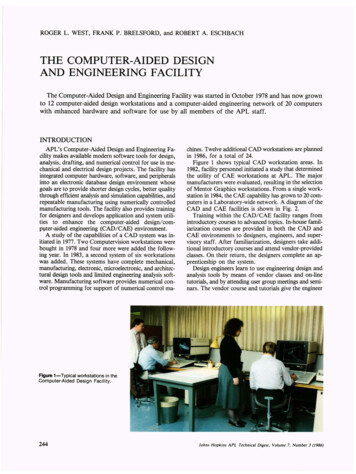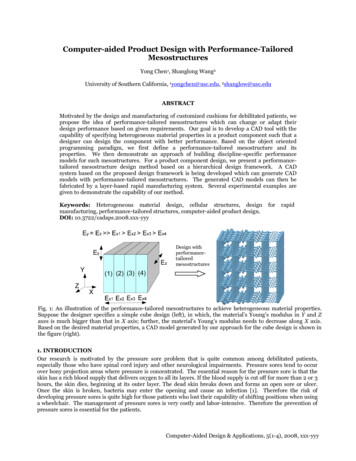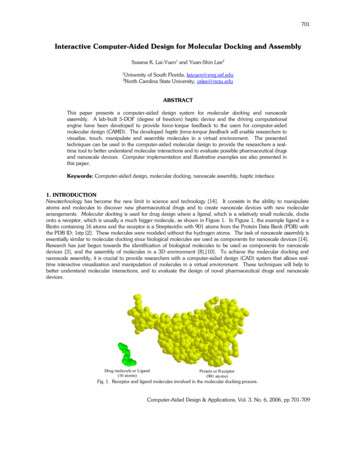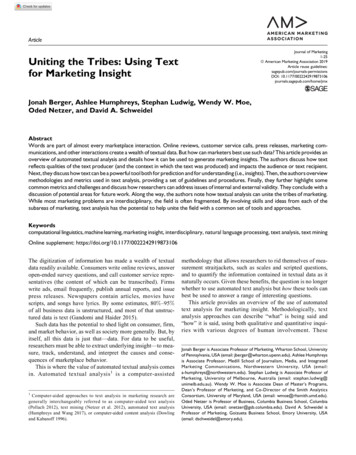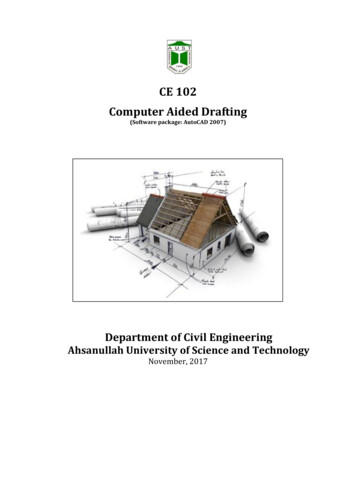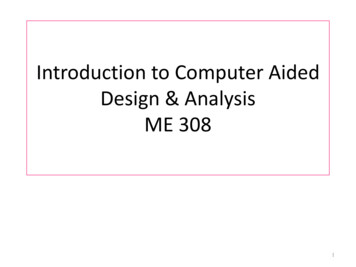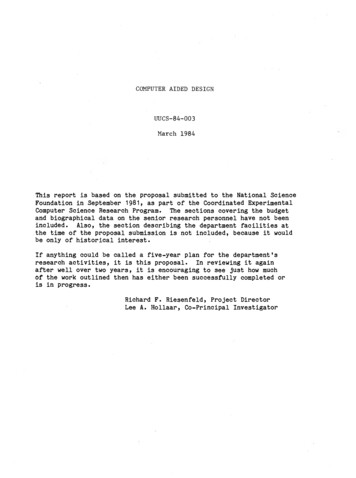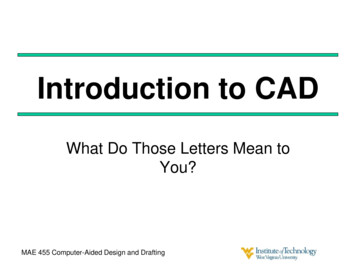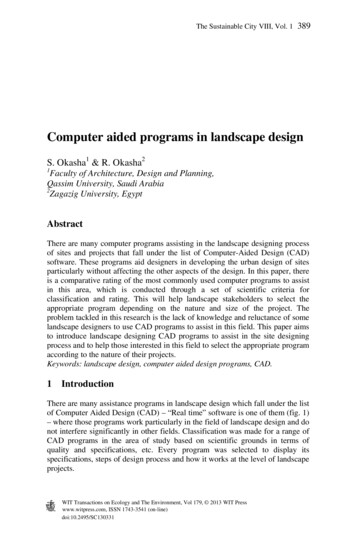
Transcription
Downloaded from orbit.dtu.dk on: Apr 19, 2022Computer aided design and analysis of reaction-separation and separation-separationsystemsMitkowski, Piotr Tomasz; Gani, Rafiqul; Jonsson, Gunnar EigilPublication date:2008Document VersionPublisher's PDF, also known as Version of recordLink back to DTU OrbitCitation (APA):Mitkowski, P. T., Gani, R., & Jonsson, G. E. (2008). Computer aided design and analysis of reaction-separationand separation-separation systems.General rightsCopyright and moral rights for the publications made accessible in the public portal are retained by the authors and/or other copyrightowners and it is a condition of accessing publications that users recognise and abide by the legal requirements associated with these rights. Users may download and print one copy of any publication from the public portal for the purpose of private study or research. You may not further distribute the material or use it for any profit-making activity or commercial gain You may freely distribute the URL identifying the publication in the public portalIf you believe that this document breaches copyright please contact us providing details, and we will remove access to the work immediatelyand investigate your claim.
Computer aided design andanalysis of reaction-separationand separation-separation systemsPh. D. ThesisPiotr Tomasz Mitkowski15 May 2008Computer Aided Process-Product Engineering CenterDepartment of Chemical and Biochemical EngineeringTechnical University of Denmark
“A pessimist finds difficulty in every opportunity;an optimist finds opportunity in every difficulty”(Unknown)
PrefaceThis thesis is submitted as partial fulfilment of the requirements for the Ph.D. degreeat Danmarks Tekniske Universitet (The Technical University of Denmark). The workhas been carried out at the Computer Aided Process-Product Engineering Center(CAPEC) at Institut for Kemiteknik (Department of Chemical and BiochemicalEngineering) from February 2005 to March 2008 under the main supervision ofProf. Rafiqul Gani and co-supervision of Prof. Gunnar Jonsson.My sincerest thanks to my supervisors Professor Rafiqul Gani and Professor GunnarJonsson who have provided all possible help and guidance when and where required.A special thanks to my main supervisor Professor Rafiqul Gani for his patience andallowing me the freedom in research, which was a great help to me for completingthis Ph-D project. Being in a very international and dynamic group such as CAPECand numerous, travels which gave me an insight to the international research was anadded bonus.Many thanks to Professor Andrzej Górak and his group at Fluid Separation,Department of Biochemical and Chemical Engineering, University of Dortmund,especially Dr.-Ing. Peter Kreis and Dipl.-Ing. Carsten Buchaly for giving anopportunity to visit and do research with them. Special thanks to Professor AndrzejGórak for inspiration and hours of discussions.I am obliged to Professor Michael Georgiadis for the opportunity to be involved inthe very interesting, challenging and demanding Research Training (Marie Curie)Network-PRISM, under the 6th Framework Programme of the EU. The financialsupport from PRISM for this Ph.D.-thesis is very much appreciated.I would like to thank all the CAPEC co-workers for technical and non-technicaldiscussions during all these years. Many thanks to Jakob, Florin, Maurizio, Hassan,Ana, Agnieszka, Naweed and Oscar for endless coffee/tea and cake breaks, forremarkable Friday Evening Seminars, for being around and helping whenever it wasneeded. Thanks to PRISM-ers, Theodoros, Nuno, Teodora, Dragan, Bogdan andOliver for sharing unforgettable time during various PRISM events around Europeand learning about different cultures. My special thanks to my officemate VipashaSoni for limitless professional and personal discussions, correcting my English anddinners in the late working hours.I want to express my gratitude to my parents for giving me a good education andteaching me that hard work is the key to success. Thanks also to them for beinginexhaustible source of inspiration and trust.Last but not the least, I want to express gratitude to my wife Iza, for her love, patienceduring countless and never ending phone calls and chats. Without Your support thiswork would never be completed.Lyngby, May 2008Piotr Tomasz Mitkowskii
ii
AbstractThis thesis describes the development and application of a general framework fordesign and analysis of integrated and hybrid chemical processes. Combination of atleast two unit operations, based on different physical phenomena, is called a hybridprocess since they jointly contribute to fulfil the process task. In principle, two typesof hybrid processes are considered in this thesis: reaction-separation where, forexample, the combination of batch reaction and membrane-based separation isconsidered, and separation-separation where, for example coupling of distillation withpervaporation is considered. An important issue in the design of hybrid chemicalprocesses is the interdependency of the combined processes.Generally, design of hybrid chemical process involves an iterative, trial and errorexperiment-based procedure where the experience of process designer plays animportant role. Since experiments are usually time consuming and expensive, thesearch space of the potential designs needs to be significantly limited. Therefore,applying a computer-aided and model-based framework can significantly help insearching the domain of potential process designs and significantly narrow downthe search space, where further optimization and experimental efforts can beconcentrated on.The key factors for the design of hybrid chemical process are the identification ofprocess boundaries (for example azeotropes, miscibility gap), selection of feasibleprocess combinations (for example to overcome azeotrope, is it better to combinedistillation with pervaporation or with ultrafiltration?) and the dependency of theperformance between constituent processes (for example how distillation should becombined with pervaporation?). Therefore, using the framework consisting of thethree stages, (1) step-by-step methodology for design and analysis of hybrid chemicalprocesses, (2) implementation, and (3) validation, it is possible to design the hybridchemical process effectively. At all the stages various computer-aided tools andmethods, some of which have been developed in this PhD-project, have been used.The identification of process boundaries is performed in a conventional way, byperforming analysis of pure component properties and mixture analysis. The drivingforce approach is used to compare various separation techniques and to select thefeasible combination of the processes. The derivative of the driving force with respectto composition of the key compound (FDx) is used to identify the “bottleneck” of theseparation technique. For instance, the occurrence of a local minimum of thederivative of the FD indicates an inefficient separation technique. Therefore, acombination of this inefficient separation technique with another separation techniquehaving a larger absolute FDx in the “bottleneck”, will lead to a hybrid chemicalprocess which is more efficient than any of the constituent separation techniquesseparately. For the purpose of simulation and evaluation of the designed hybridchemical process, specific models are generated from a generic model. The genericmodel describes the superstructure of two integrated processes, which under certaincombination results in a hybrid process configuration.iii
The application of the developed model-based framework has been illustrated throughfive case studies involving reaction, distillation and membrane-based separationprocesses. The first case study deals with separation of a binary mixture of acetic acidand water. In this case two hybrid process designs consisting of distillation andpervaporation are proposed. This is followed by case study investigating the use ofhybrid processing schemes to enhance production of modified phosphatidylcholine.Modified phosphatidylcholine is obtained in interesterification reaction of originalphosphatidylcholine and oleic acid. The last three case studies deal with esterificationreactions catalysed by the enzyme (esterification of cetyl oleate) or by ionic-exchangecatalysts (esterification of ethyl lactate and n-propyl propionate). In all case studiesinvolving reaction, hybrid process configurations consisting of reactors andpervaporations integrated at different levels, are proposed. It is important to point outthat one of the hybrid chemical process designs has been verified experimentally. Itwas done for batch reactor combined with pervaporation to improve product yield insynthesis of n-propyl propionate.It should also be noted that the framework is capable to be applied to other chemicaland biochemical process design problems where integration of reaction-separationand separation-separation processes is looked for. It is not limited to only the fivecase studies discussed in this thesis. The framework is only limited by the availabilityof the property data of compounds, separation and reaction models.iv
Resume på DanskDenne afhandling omhandler udviklingen og anvendelse af en generel metode fordesign og analyse af integrerede og hybride kemiske processer. En hybrid proces erdefineret som en proces hvor to eller flere enhedsoperationer, baseret på forskelligefysiske principper, kombineres for at udfører en overordnet operation. To typer afhybride processer er behandlet i denne afhandling: Reaktion/separation processerhvor f. eks. kombinationen af en batch reaktor og membran separation er benyttet.Separation/separation processer hvor f. eks. kombinationen af destillation ogpervaporation er benyttet. Et vigtigt element i design af hybride kemiske processer erinteraktionen mellem de kombinerede enhedsoperationer.Design af hybride systemer indbefatter generelt en iterativ og trail and erroreksperiment baseret procedure hvor erfaring og proces kendskab er helt centralt.Eftersom eksperimentelt arbejde typisk er meget tids- og resursekrævende er detnødvendigt, at begrænse operations området af potentielle design betragteligt. Dennebegrænsning taler for at anvende en model- og computerbaseret metode til atbestemme mulige design. Simulering kan yderligere bidrage til at afsøge domainet afmulige design for, at begrænse området af interessante design og derved begrænse detefterfølgende eksperimentelle arbejde og optimeringen.De centrale elementer i design af hybride processer er identifikationen af procesbegrænsninger, f. eks. azeotrope eller flerfase bladninger. Udvælgelse af muligedesign kombination, f. eks. for at eliminere effekten af en azeotrop, er kombinationenaf destillation og pervaporation eller destillation og ultrafiltrering bedst?Undersøgelse af indvirkningen af de enkelte enhedsoperationer på den resulterendeydelse, det vil f.eks. sige hvordan skal destillation og pervaporation processernekombineres. Den præsenterede metode består derfor af følgende tre dele: (1) trin fortrin metode for design og analyse af hybride kemiske processer, (2) implementeringog (3) validering. Denne metode muliggøre et effektivt design af hybride kemiskeprocesser. I alle tre trin benyttes computer simulerings værktøjer som er blevetudviklet som del af dette Ph.d. arbejde.Identifikation of procesbegrænsninger udføres på klassisk vis ved analyse afegenskaber for rene komponenter og analyse af bladninger. For at sammenlignemulige separations tekniker og udvælge mulige kombinationer of enhedsoperationerbenyttes driving force analyse. Dennes afledte med hensyn til koncentrationen afnøgle komponenten (FDx) benyttes til at identificere ”flaske halsen” for enseparations teknik. F. eks. et lokalt minimum for den afledte af FD indikere ineffektivseparation. Kombinationen af en ineffektiv separations teknik med en teknik der haren større værdi for FDx i ”flaske halsen” giver en hybrid kemisk proces, som vil havebedre separations egenskaber end de separate enhedsoperationer hver for sig. For atkunne simulere og evaluere den hybride kemiske proces er specifikke modeller udledtaf en generisk model. Den generiske model beskriver en superstruktur for tointegrerede processer for hvilken specielle kombinationer resultere i en konfigurationmed en hybrid proces.v
Anvendelsen af den udviklede modelbaserede metode er vist ved hjælp af femillustrative eksempler. De involvere reaktion, destillation og membranbaseretseparation. Det første eksempel viser separation af en binær blanding af vand ogeddikesyre. Der argumenteres for en hybride proces bestående af destillation ogpervaporation. Det andet eksempel undersøger anvendelsen af en hybrid proces til atforbedre inter-esterfikations reaktionen for phosphatidylcloline. De sidste treeksempler omhandler enzymatisk esterfikation af cetyl oleate og esterfikation af ethyllactate og n-propyl propionate med en ionbytter katalysator. I alle eksempler derinvolvere reaktion, er et design af den hybride proces bestående af reaktorer ogpervaporation integreret på forskellige niveauer forslået. Eksemplet med den hybrideproces bestående af batch reaktion og membran separation af n-propyl propionate erblevet verificeret eksperimentelt som væsentlig del af dette arbejde.Det skal bemærkes, at den modelbaserede metoden er generel anvendelig til andretyper af kemiske eller biokemiske processer hvor integration af reaktion/separation ogseparation/separation indgår. Metoden er ikke begrænset til de fem eksampler, derindgår i denne tese. Metoden er begrænset til problemer hvor modeller for reaktion ogseparation haves, samt data for de fysiske egenskaber for all indbefattede kemikalier.vi
Contents1. Introduction12. Theoretical background52.1. Introduction. 52.2. Hybrid processes. 52.3. Separation and reactive processes . 82.3.1. Separation processes. 82.3.2. Solvent-based separation processes. 92.3.3. Reactive processes. 112.3.4. Solvent-based reactive processes . 112.3.5. Phase and reaction equilibrium: Reactive flash. 142.4. Membrane-based separation processes. 172.4.1. Pervaporation. 212.4.1.1.Solution-diffusion model . 222.4.1.2.Semi-empirical model after Meyer-Blumenroth. 242.4.1.3.Empirical models . 252.4.1.4.Short-cut models . 262.5. Property models . 272.5.1. Pure component properties . 272.5.2. Activity coefficient models . 282.5.2.1.UNIFAC. 302.6. Process synthesis . 312.6.1. Heuristics or knowledge based methods . 322.6.2. Optimisation-based methods . 332.6.3. Hybrid methods . 332.6.3.1.Method based on thermodynamic insights . 332.6.3.2.Driving force based synthesis and design. 342.6.3.3. Process flowsheet generation and design through a groupcontribution approach . 353. General framework for design and analysis of hybrid andintegrated processes37vii
3.1. Introduction .373.1.1. Motivating example .373.1.2. Problem formulation .413.2. Framework for hybrid process design and analysis .423.2.1. Stage 1: Hybrid process design and analysis .423.2.1.1.Step 1a: Separation task and reaction data analysis .433.2.1.2.Step 1b: Need of solvent .453.2.1.3.Step 2: Determine process demands.453.2.1.4.Step 3: Selection of separation techniques .453.2.1.5.Step 4: Establish process conditions .573.2.2. Stage 2: Implementation .683.2.3. Stage 3: Validation.683.3. Computer-aided tools in the Framework .683.3.1. Integrated Computer-Aided System for designing, analysing andsimulating chemical processes: ICAS.683.3.1.1.The CAPEC database .703.3.1.2.ICAS-ProPred: Property prediction toolbox .703.3.1.3.ICAS-TML: thermodynamic model library .703.3.1.4.Utility toolbox in ICAS .713.3.1.5. ICAS-PDS: Process Design Studio .713.3.1.6.ICAS-ProCAMD: Computer Aided Molecular Design .713.3.1.7.ICAS-MoT: Modelling Test Bed .713.3.2. MemData: Membrane database .723.3.2.1.Existing membrane databases .733.3.2.2.Structure of the MemData database .753.3.2.3.The MemData implementation.794. Case studies854.1. Introduction .854.2. Separation-Separation systems .854.2.1. Separation of binary mixture of water and acetic acid .854.2.1.1. Step 1a: Separation task analysis .86viii
4.2.1.2.Step 1b: Need of solvent . 884.2.1.3.Step 2: Determine process demands . 884.2.1.4.Step 3: Selection of separation techniques. 884.2.1.5.Step 4: Establish process conditions . 934.3. Reaction-Separation systems . 994.3.1. Synthesis of cetyl-oleate. 994.3.1.1.Step 1a: Reaction data analysis. 994.3.1.2.Step 1b: Need of solvent . 1034.3.1.3.Step 2: Determine process demands . 1034.3.1.4.Step 3: Selection of separation techniques. 1034.3.1.5.Step 4: Establish process conditions . 1064.3.2. Enzymatic interesterification of phosphatidylcholine . 1114.3.2.1.Step 1a: Reaction data analysis. 1114.3.2.2.Step 1b: Need of solvent . 1154.3.2.3.Step 2: Determine process demands . 1154.3.2.4.Step 3: Selection of separation techniques. 1154.3.2.5.Step 4: Establish process conditions . 1224.3.3. Synthesis of ethyl lactate . 1254.3.3.1.Step 1a: Separation task and reaction data analysis. 1264.3.3.2.Step 1b: Need of solvent . 1314.3.3.3.Step 2: Determine process demands . 1324.3.3.4.Step 3: Selection of separation techniques. 1324.3.3.5.Step 4: Establish process conditions . 1354.3.4. Synthesis of n-propyl-propionate . 1424.3.4.1.Stage 1: Hybrid process design and analysis . 1424.3.4.2.Stage 2: Implementation . 1554.3.4.3.Stage 3: Validation. 1625. Conclusions1735.1. Achievements . 1735.2. Recommendation for future work. 1756. Appendixes177ix
6.1. Appendix 1: Reactive flash calculation.1776.2. Appendix 2: Activity coefficient models .1816.2.1. Modified UNIFAC (Lyngby).1816.2.2. Modified UNIFAC (Dortmund).1846.3. Appendix 3: MemData.1876.4. Appendix 4: Supplements to the case studies .1926.4.1. Supplement to the case study of synthesis of cetyl oleate .1936.4.1.1.oleateModel for batch reactor for enzymatic esterification of cetyl.1936.4.1.2.Model used in the case study of synthesis of cetyl oleate.1976.4.1.3.oleateUNIFAC parameters used in the case study of synthesis of cetyl.2026.4.2. Supplement to the case study of interesterification ofphosphatidylcholine .2046.4.2.1.Model for enzymatic interesterification in the batch operation 2046.4.2.2.Model for membrane assisted batch reaction .2106.4.3. Production of ethyl lactate .2136.4.3.1. Model for heterogeneously catalyzed synthesis of ethyl lactate inbatch reactor .2136.4.3.2.Model for membrane assisted batch reaction .2166.4.3.3.lactateUNIFAC parameters used in the case study of synthesis of ethyl.2196.4.4. Production of n-propyl propionate.2206.4.4.1.Model for heterogeneously catalysed batch reaction .2206.4.4.2.Model for membrane-based separation: pervaporation.2216.4.4.3.Model for membrane assisted batch reaction .2236.4.4.4.Experimental data in tables .2277. Nomenclature2358. References2419. Index249x
List of TablesTable 2.1: Ranges of membrane processes application . 21Table 2.2: Experimental and semi-experimental correlations of permeance. 27Table 2.3: The main differences between Modified UNIFAC (Lyngby) and ModifiedUNIFAC (Dortmund). 31Table 3.1: Parameters for conceptual hybrid process modelling . 40Table 3.2: Pure component and mixture properties for solvent selection problem forthree separation techniques. E: essential property, D: desired property. (Based onHarper, 2002) . 47Table 3.3: Properties used to addressing the environmental, health and safetyconsideration (adapted from Harper, 2002) . 55Table 3.4: Scores table (adapted from Gani et al., 2005). 55Table 3.5. Candidate processes for hybrid operation schemes . 56Table 3.6: List of variables in general hybrid process model (NC: number ofcomponents, NRK: number of independent homogeneous reactions, NRKh: number ofindependent heterogeneous reactions) . 61Table 3.7: List of equations present in the general hybrid process model (NC: numberof components, NRK: number of independent homogeneous reactions, NRKh: numberof independent heterogeneous reactions). 64Table 3.8. Computer-aided tools used in the framework. 69Table 3.9 Summary of data reported in the existing membrane databases. 75Table 3.10: Experimental and semi-experimental correlations of permeabilityincluded in MemData. 79Table 3.11: MemData in numbers . 84Table 4.1: Pure component properties of water and acetic acid . 86Table 4.2: Estimated parameters for Modified UNIFAC (Lyngby) . 87Table 4.3: Ri and Qi for Modified UNIFAC (Lyngby) . 87Table 4.4: Representation of compounds in terms of Modified UNIFAC (Lyngby)groups. 87Table 4.5. Process parameters and heat requirements for DFP configuration. 99Table 4.6. Process parameters and heat duties for DSP configuration . 99Table 4.7: Pure component properties of cetyl alcohol, oleic acid, cetyl oleate andxi
water .100Table 4.8. List of azeotropes present in analysed mixture .101Table 4.9. Relative volatility of components in the post reaction mixture computed at38.56 kPa and 348.15 K. .105Table 4.10 Process parameters and process conversions. 5 w% of Novozym 435.108Table 4.11: Compound properties obtained from CAPEC database.113Table 4.12: Properties of compounds absent in CAPEC database. 113Table 4.13. List of azeotropes present in the analysed mixture (Mod. UNIFAC(Lyngby) and SRK equation of state).114Table 4.14. Relative volatility of compounds in the post reaction mixture computed at20.0 kPa and 333.15 K .117Table 4.15: Properties of solvent generated by ICAS-ProCAMD .119Table 4.16: List of feasible solvents with their RS values .120Table 4.17: List of feasible solvents with their scores .121Table 4.18: Process parameters and process yields. Switching time tswitch 0 .124Table 4.19: Various membranes versus different solvents. Switching time tswitch 5 h.125Table 4.20. Properties of pure compounds (obtained from CAPEC Database) .127Table 4.21. Reaction mixture analysis (SMSwin). UNIFAC (Original) and SRK. .127Table 4.22. Chemical element matrix representing the synthesis of ethyl lactate fromethanol and lactic acid (Eq. (4.26)) .130Table 4.23. Comparison of experimental equilibrium data with reactive flashcalculation at T 368.15 K, P 2 atm. .130Table 4.24. Relative volatility of compounds in the post reaction mixture computed atboiling point .133Table 4.25: Initial conditions for different rea
three stages, (1) step-by-step methodology for design and analysis of hybrid chemical processes, (2) implementation, and (3) validation, it is possible to design the hybrid chemical process effectively. At all the stages various computer-aided tools and methods, some of which
